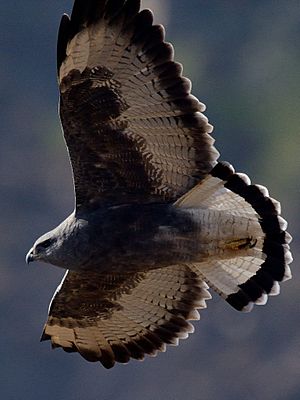Variable hawk facts for kids
Quick facts for kids Variable hawk |
|
|---|---|
 |
|
| Female in the Falkland Islands | |
| Conservation status | |
| Scientific classification | |
| Genus: |
Geranoaetus
|
| Species: |
polyosoma
|
| Subspecies | |
|
|
| Synonyms | |
|
Buteo poecilochrous Gurney, 1879 |
|
The variable hawk (Geranoaetus polyosoma) is a type of bird of prey that lives in South America. It's known for its many different looks and colors, which is why it's called "variable"! These powerful birds belong to the family Accipitridae, which includes eagles, hawks, and kites. You can often spot them soaring high in the sky over open areas.
This hawk is common in western and southern South America, including the Falkland Islands. Scientists have debated if it's one species or two different ones: the red-backed hawk and the Puna hawk. However, most experts now agree they are all part of the same variable hawk species. There's also a rare type from the Juan Fernández Islands that looks a bit different.
Contents
What Does the Variable Hawk Look Like?
The variable hawk truly lives up to its name because both male and female birds can have many different colors and patterns. This is called being "polymorphic," meaning they have many forms.
All adult variable hawks have a white tail with a clear black band near the end. Their wings are grey with dark stripes. When they fly, you can see their wing feathers are whitish with thin stripes and a wide black tip. The rest of their feathers can be very dark grey or even whitish. Some birds might have reddish-brown feathers on their undersides.
Female hawks usually have a reddish-brown back, which most males do not. However, some males can also have this color. The hawks from the Juan Fernández Islands are less varied. Adults there are usually whitish underneath and grey on top. Scientists have found at least 27 different adult feather patterns for this species! This might be more than any other bird of prey.
How Big Are Variable Hawks?
The size of these hawks can also vary a lot. They can be anywhere from 45 to 62 centimeters (18 to 25 inches) long. Their wingspan, which is how wide their wings stretch, can be from 113 to 151 centimeters (45 to 60 inches). They can weigh from 800 grams to over 1,800 grams (1.8 to 4 pounds).
The Puna hawk type is generally larger, while the red-backed hawk type is usually smaller. The Juan Fernández hawk is somewhere in the middle. But it can be hard to tell the difference in size when you see them in nature. Overall, the variable hawk is considered a large hawk.
Where Do Variable Hawks Live?
Variable hawks live in open areas at all different heights, from sea level to high mountains. The red-backed hawk type lives in the most places. You can find them in mountains above the tree line, on coastal hills, in grassy plains called Patagonian steppes, and near farms. They also live at the edges of forests and humid mountain woods.
Even though the red-backed hawk can be found in lower areas, it's not very common below 500 meters (about 1,640 feet). They are often seen up to 3,000 meters (about 9,840 feet) high. The Juan Fernández hawk lives on the volcanic slopes and grasslands of its islands.
The Puna hawk type often lives in very high places, like the páramo and puna grassland habitats, which are over 5,000 meters (about 16,400 feet) high. This is higher than almost any other bird of prey! Some Puna hawks might visit mountain bushes and small forests as low as 900 meters (about 2,950 feet), but rarely below 2,900 meters (about 9,500 feet).
What Do Variable Hawks Eat?
Variable hawks are often seen soaring high on warm air currents. They also like to sit on tall spots like sign posts or large trees. They hunt almost any small to medium-sized animal they can catch. In some studies, small mammals make up more than 90% of their diet.
Some of their favorite foods include cavies, tuco-tucos, rabbits, mice, and páramo rats. They also eat Earthworms, weevils, grasshoppers, and other small creatures. Sometimes, they catch birds, especially tired petrels around the Juan Fernández Islands. Other prey can include other rodents, rabbits and hares, frogs, lizards, snakes, and even fish. The variable hawk hunts by spotting its prey from the air while soaring, then swooping down to catch it on the ground.
Reproduction and Life Cycle
Variable hawks breed at different times of the year, depending on where they live. They build large nests made of sticks on any tall structure they can find. Sometimes, other hawks even help them raise their young!
They usually lay one to three eggs. The eggs hatch after 26 to 36 days. The young hawks, called nestlings, stay in the nest for 40 to 74 days before they are ready to fly. Hawks that live in higher, colder places tend to take longer to hatch and much longer to fledge than those living in lower areas.
See also
 In Spanish: Busardo dorsirrojo para niños
In Spanish: Busardo dorsirrojo para niños



